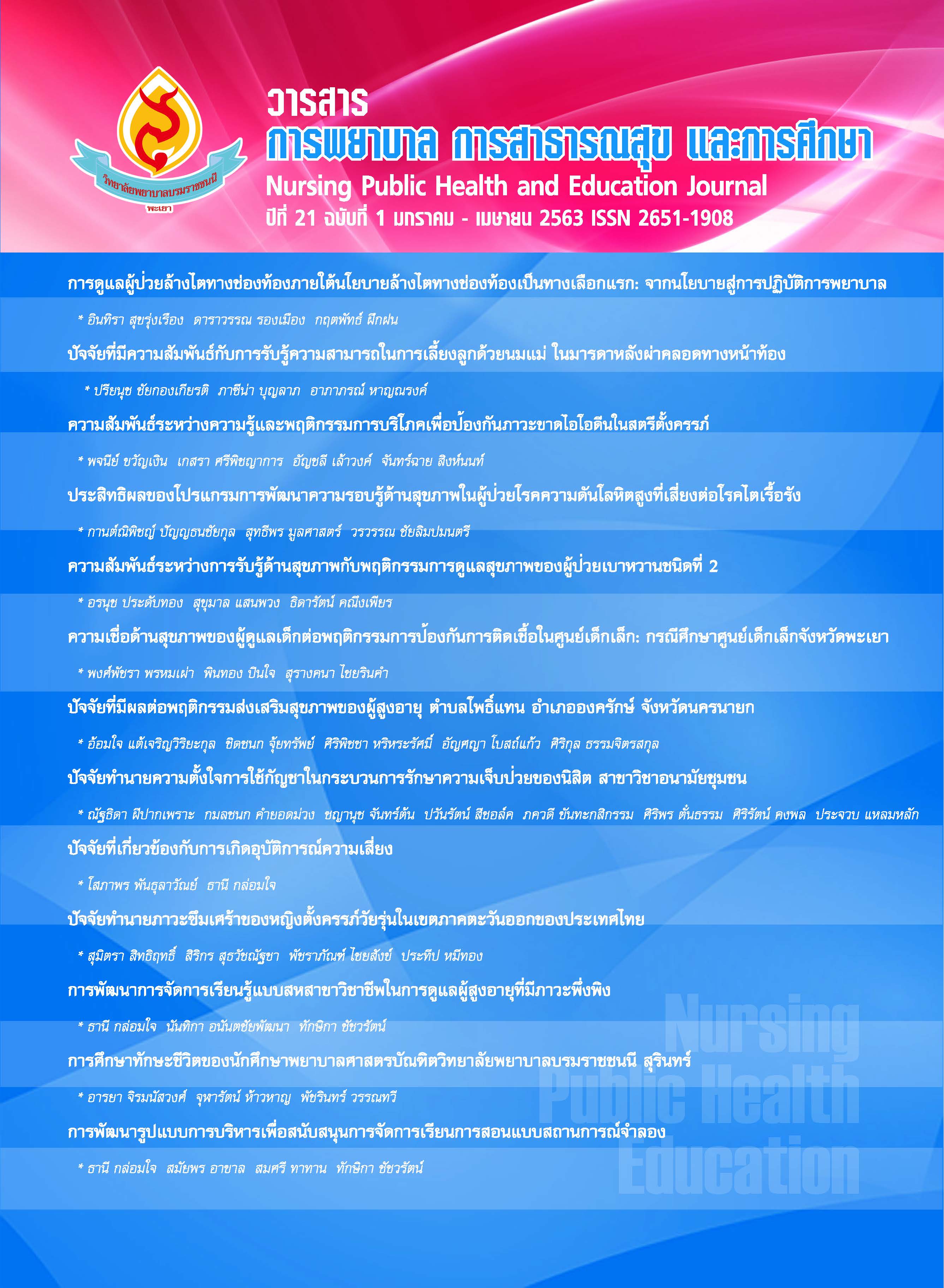ปัจจัยที่มีความสัมพันธ์กับการรับรู้ความสามารถ ในการเลี้ยงลูกด้วยนมแม่ ในมารดาหลังผ่าคลอดทางหน้าท้อง
คำสำคัญ:
การรับรู้ความสามารถในการเลี้ยงลูกด้วยนมแม่, มารดาหลังผ่าคลอดทางหน้าท้อง, ภาวะซึมเศร้าหลังบทคัดย่อ
การวิจัยนี้มีวัตถุประสงค์เพื่อศึกษาการรับรู้ความสามารถในการเลี้ยงลูกด้วยนมแม่และวิเคราะห์ปัจจัยที่มีความสัมพันธ์กับการรับรู้ความสามารถในการเลี้ยงลูกด้วยนมแม่ในมารดาหลังผ่าคลอดทางหน้าท้องประชากรเป็นมารดาหลังผ่าคลอดทางหน้าท้องที่นอนพักรักษาตัวในแผนกสูติกรรมหลังคลอด โรงพยาบาลศูนย์ยะลา กลุ่มตัวอย่างจำนวน 123 คน เลือกตัวอย่างแบบเจาะจง (Purposive sampling) เป็นมารดาหลังผ่าคลอดทางหน้าท้องวันที่ 3 ไม่มีภาวะแทรกซ้อนหลังผ่าคลอด เครื่องมือที่ใช้ในการวิจัยเป็นแบบสอบถามที่ผู้วิจัยพัฒนาขึ้น แบ่งออกเป็น 3 ตอนประกอบด้วยตอนที่ 1 ข้อมูลทั่วไป ตอนที่ 2 แบบวัดภาวะซึมเศร้าหลังคลอด และตอนที่ 3 แบบวัดการรับรู้ความสามารถในการเลี้ยงลูกด้วยนมแม่ นำแบบวัดทั้งฉบับไปตรวจความตรงเชิงเนื้อหา ผ่านผู้ทรงคุณวุฒิจำนวน 3 คน หาค่าดัชนีความสอดคล้อง วิเคราะห์ได้ค่า IOC ระหว่าง 0.67 - 1.00 และหาค่าสัมประสิทธิ์แอลฟ่าของครอนบาชได้ค่าความเชื่อมั่นเท่ากับ 0.89 วิเคราะห์ข้อมูลโดยการแจกแจงความถี่ ค่าร้อยละ ค่าเฉลี่ย และส่วนเบี่ยงเบนมาตรฐาน แปลผลค่าคะแนนตามเกณฑ์ และหาความสัมพันธ์โดยใช้สัมประสิทธิ์สหสัมพันธ์ของเพียร์สันและสเปียร์แมนแรงค์ผลการวิจัยพบว่า มารดาหลังผ่าคลอดทางหน้าท้องที่เป็นกลุ่มตัวอย่าง มีอายุอยู่ในช่วง 31-45 ปี ร้อยละ 39.0 จำนวนครั้งของการคลอดบุตรอยู่ระหว่าง 0-1 ครั้ง ร้อยละ 40.7 และมีภาวะซึมเศร้าหลังคลอด ร้อยละ 25.2 มารดามีการรับรู้ความสามารถในการเลี้ยงลูกด้วยนมแม่ในระดับสูง ร้อยละ 62.6 โดยรับรู้ในเรื่องสมาชิกในครอบครัวช่วยอำนวยความสะดวกให้เลี้ยงลูกด้วยนมแม่ มีค่าเฉลี่ยสูงสุด (M = 4.14, SD. = 1.11) ส่วนในเรื่องสามารถประเมินได้ว่าลูกได้รับน้ำนมเพียงพอ มีค่าเฉลี่ยต่ำสุด (M = 3.42, SD. = 1.28) ผลการวิเคราะห์ความสัมพันธ์พบว่า อายุมารดา จำนวนครั้งของการคลอดบุตร และคะแนนภาวะซึมเศร้าหลังคลอด ไม่มีความสัมพันธ์กับการรับรู้ความสามารถในการเลี้ยงลูกด้วยนมแม่ (r = .07, p = .23) (r = .12, p = .09) (r = .-.14, p = .12) ตามลำดับ จากข้อค้นพบของการวิจัยนี้ แสดงให้เห็นว่ามารดาหลังผ่าคลอดทางหน้าท้อง รับรู้ความสามารถในการเลี้ยงลูกด้วยนมแม่ในระดบสูง โดยไม่ขึ้นกับอายุมารดา จำนวนครั้งของการคลอดบุตร และคะแนนภาวะซึมเศร้าหลังคลอดพยาบาลวิชาชีพที่เกี่ยวข้องทั้งในแผนกฝากครรภ์ ห้องคลอด และแผนกหลังคลอด จึงควรให้ข้อมูลและความรู้ตั้งแต่ฝากครรภ์ เพื่อให้มารดามีความมั่นใจ และมีการรับรู้ความสามารถในการเลี้ยงลูกด้วยนมแม่ที่ถูกต้องให้การช่วยเหลือจนประสบความสำเร็จ มีน้ำนมเพียงพอให้บุตร ทั้งในขณะอยู่โรงพยาบาลและดูแลต่อเนื่องที่บ้าน
เอกสารอ้างอิง
กนกวรรณ โคตรสังข์, ศิริวรรณ แสงอินทร์, และอุษา เชื้อหอม. (2559). ผลของโปรแกรมการกระตุ้นการหลั่งน้ำนมต่อระยะเวลาการเริ่มไหลของน้ำนม ระยะเวลาการมาของน้ำนมเต็มเต้า และการรับรู้ความสามารถในการเลี้ยงลูกด้วยนมแม่ ในมารดาหลังผ่าตัดคลอดบุตรทางหน้าท้อง. วารสารคณะพยาบาลศาสตร์มหาวิทยาลัยบูรพา, 24(1), 13-26.
กัลพร ยังดีและชุติมา หรุ่มเรืองวงษ์. (2559). ภาวะซึมเศร้าหลังคลอดในมารดาที่มีภาวะแทรกซ้อนทางสูติศาสตร์ในโรงพยาบาลจุฬาลงกรณ์. จุฬาลงกรณ์เวชสาร, 60(5), 561-574.
คชารัตน์ ปรีชล. (2559). ภาวะซึมเศร้าหลังคลอด: การป้องกันและการดูแล. วารสารพยาบาลสภากาชาดไทย, 9(2), 24-35.
ดวงกมล ปิ่นเฉลียว และพรพรรณ ภูสาหัส. (2558). ปัจจัยที่มีความสัมพันธ์กับความทุกข์ทรมานของสตรีหลังผ่าตัดคลอดทางหน้าท้อง. วารสารพยาบาลทหารบก, 16(1), 101-108.
ธิดารัตน์ หวังสวัสดิ์, นันทา กาเลี่ยง, อนงค์ ภิบาล, รัตนา ใจสมคม, และวนิสา หะยีเซะ. (2557). ปัจจัยที่มีอิทธิพลต่อความตั้งใจในการเลี้ยงลูกด้วยนมแม่อย่างเดียวนาน 6 เดือน ของมารดาในจังหวัดนราธิวาส. พยาบาลสาร, 41(5), 123-133.
บรรจง จารุวงศ์. (2551). ความปวด การจัดการกับความปวดและผลของความปวดของผู้ป่วยหลังผ่าตัดช่องท้องในโรงพยาบาลสรรพสิทธิประสงค์. (วิทยานิพนธ์ปริญญาพยาบาลศาสตรมหาบัณฑิต). ขอนแก่น. มหาวิทยาลัยราชธานี.
โบว์ชมพู บุตรแสงดี, กรรณิการ์ กันธะรักษา, และจันทรรัตน์ เจริญสันติ. (2556). ผลของการส่งเสริมสมรรถนะแห่งตนต่อความสำเร็จในการเลี้ยงลูกด้วยนมมารดาอย่างเดียวของมารดาที่ผ่าตัดคลอดทางหน้าท้อง. พยาบาลสาร, 40(3), 1-10.
พรณิศา แสนบุญส่ง และวรรณดา มลิวรรณ์. (2559). การเลี้ยงลูกด้วยนมแม่อย่างมีคุณภาพ: ปัจจัยที่มีอิทธิพลต่อการเลี้ยงลูกด้วยนมแม่ และบทบาทของพยาบาลผดุงครรภ์. วารสารวิชาการมหาวิทยาลัยปทุมธานี, 8(2), 225-237.
พรนภา ตั้งสุขสันต์. (2554). การส่งเสริมการเลี้ยงลูกด้วยนมแม่ในสตรีตั้งครรภ์. วารสารพยาบาลสาธารณสุข, 25(3), 103-119.
ศิริวรรณ แสงอินทร์. (2554). แบบวัดระดับการรับรู้ความสามารถในการเลี้ยงลูกด้วยนมแม่ฉบับสั้นของเดนนิส (breastfeeding self-efficacy scale - short form) (อัดสำเนา).
ศศิธารา น่วมภา, นิตยา สินสุกใส, วรรณา พาหุวัฒนกร, และพฤหัส จันทร์ประภาพ. (2556). ปัจจัยส่วนบุคคลเวลาที่เริ่มให้นมแม่ และการสนับสนุนจากพยาบาลในการทำนายความสำเร็จในการเลี้ยงลูกด้วยนมแม่อย่างเดียวก่อนจำหน่าย ในมารดาหลังผ่าตัดคลอด. วารสารพยาบาลศาสตร์ . 31(2), 49-59.
สำนักงานสถิติแห่งชาติ. (2559). รายงานสถิติรายปีประเทศไทย 2559. กรุงเทพฯ: สำนักงานสถิติแห่งชาติ.
สำนักสารนิเทศ สำนักงานปลัดกระทรวงสาธารณสุข. (2562). กรมอนามัยจับมือ WHO-ยูนิเซฟ-มูลนิธิศูนย์นมแม่แห่งประเทศไทย เสริมพลังนมแม่ และเทคนิค 3 ดูดให้คุณค่านมแม่ครบถ้วน. สืบค้นเมื่อ 21 สิงหาคม 2562, จากhttps://pr.moph.go.th/?url=pr/detail/2/02/130452/
สุดาภรณ์ พยัคฆเรือง, พรรณรัตน์ แสงเพิ่ม, และชญาดา สามารถ. (2559). ปัญหาการเลี้ยงลูกด้วยนมแม่ระยะแรกหลังคลอด: ประสบการณ์ของมารดา. วารสารพยาบาลศาสตร์, 34(3), 30-40.
เอมอร บุตรอุดม. (2555). ความสัมพันธ์ระหว่างความพร้อมกับการยอมรับและพฤติกรรมการเลี้ยงบุตรด้วยนมมารดาของมารดาหลังผ่าตัดคลอดในโรงพยาบาลสังกัดกระทรวงสาธารณสุข จังหวัดขอนแก่น. วารสารวิทยาลัยพยาบาลบรมราชชนนี นครราชสีมา, 18(1), 29-38.
Dennis, C. L. (2003). The breastfeeding self-efficacy scale: Psychometric assessment of the short form. Journal of Obstetric, Gynecologic and Neonatal Nursing, 32(6),734-744.
Krejcie, R. V., & Morgan, D. W. (1970). Determining Sample Size for Research Activities.Educational and Psychological Measurement, 30(3), 607-610.
Porter, M. V., Teijlingen, E., Chi Ying. & Bhattacharya, S. (2007). Satisfaction with cesarean section: Qualitative analysis of open-ended questions in a large postal survey. Birth, 34 (2),148-154.
UNICEF. (2014). UNICEF Annual Report 2014. New York, NY: United Nations Children’s Fund (UNICEF)
World Health Organization. (2007). The world health report 2007: a safer future: Global public health security in the 21st century. France: Raphael Crettaz.
ดาวน์โหลด
เผยแพร่แล้ว
รูปแบบการอ้างอิง
ฉบับ
ประเภทบทความ
สัญญาอนุญาต
ลิขสิทธิ์ (c) 2020 วารสารการพยายาล การสาธารณสุข และการศึกษา

อนุญาตภายใต้เงื่อนไข Creative Commons Attribution-NonCommercial-NoDerivatives 4.0 International License.



